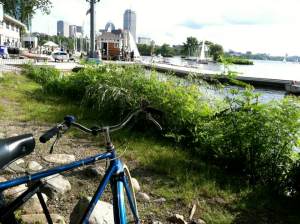In his column “Make Boston bicycle-free,” appearing in the Boston Globe on Friday, July 15, Brian McGrory rails against bicyclists for their supposed self-righteous superiority. By profiling people based on their preferred means of getting around, McGrory betrays his own narrow-minded approach to our urban transportation landscape – and betrays his city’s future in the process.
Unlike the self-celebratory, proselytizing, Lycra-wearing enthusiasts McGrory describes, I only recently – and timidly so – purchased a used three-speed and began biking to work one or two days a week via a route that avoids street traffic as much as possible. I have enjoyed this new infusion of variety (and physical activity) in my arsenal of available transportation options, which already included the increasingly unreliable T and bus system, my Zipcar membership, and the forgotten art of walking.
My reluctance to join the world of bicycling stemmed primarily from safety concerns. While McGrory berates the city’s bicyclists for their reckless actions, Boston’s infamous drivers speed around in enormous high-powered vehicles capable of inflicting much more severe bodily harm than a bicycle. McGrory is right to scold bicyclists for dangerous behavior. But rather than mocking programs that pass out free bicycle helmets, he should promote safety and education programs for bicyclists. Unlike motorists, who receive state-mandated drivers education, bicyclists cannot be expected to consistently understand safe biking practices without similarly pervasive education programs.
Another grievance sounded in the article is the sense of entitlement bicyclists feel on roads that were “built for cars.” According to MassBike, most areas of Boston and Cambridge are considered business districts, where bicycles are not allowed to ride on the sidewalk. This arrangement leaves bicyclists in no man’s land, to which McGrory responds that, while “these cyclists are more than welcome in the suburbs,” once they get to the city line they should lock up their bikes and look for the nearest cab.
From a purely economic standpoint, this proposal makes little sense. Despite McGrory’s claims about who has the right to the road, both bicyclists and motorists presumably pay taxes. In fact, bicyclists are perhaps more likely to live and pay taxes in Boston than auto commuters. Yet, despite paying the same taxes as the owners of the mammoth SUVs that pound the pavement every morning and evening rush hour, bicycles contribute comparatively little to the deterioration of our roads. The gas tax is the only tax that charges drivers more per vehicle mile traveled and should be raised to more accurately reflect the contribution of these miles on the cost of road maintenance.
Furthermore, urban real estate is expensive, especially in Boston. Whereas one commuter on a bicycle has a footprint of maybe 15 square feet (6 ft by 2.5 ft), the same commuter in even a modestly-sized Honda Civic would take up some 85 square feet of prime real estate, more than five times the space (not to mention the discrepancy in carbon footprint). If the Civic driver asked a real estate agent for five times the space as the bicyclist for the same price, the agent would surely direct the driver (not the biker) toward the suburbs. But McGrory’s policy proposal would do the opposite. An alternative solution used in cities like London and Stockholm is a congestion pricing system that charges cars for bringing their bloated Filet-of-Fish-stuffed cabooses onto the high-priced city streets.
The National Complete Streets Coalition and local groups such as the Livable Streets Alliance promote road design that takes into account the safety and enjoyment of all users, including cars and bicyclists, but also public transportation users and vehicles, and pedestrians, regardless of age or ability. U.S. transportation policy for nearly the last century has favored McGrory’s supposed victims. While the addition of bike lanes throughout the city has encouraged more Bostonians to adopt this active means of transport, most parents would not expose their children to bicycling along a tightrope between speeding traffic and the unpredictability of parked car doors – a protected bike lane would provide a more complete solution.
Rather than a ban on bicycles, Boston needs to promote safety and education programs for bicyclists, sounder pricing approaches for urban streets, and better roadway infrastructure to allow all users to move around in transportation harmony.
